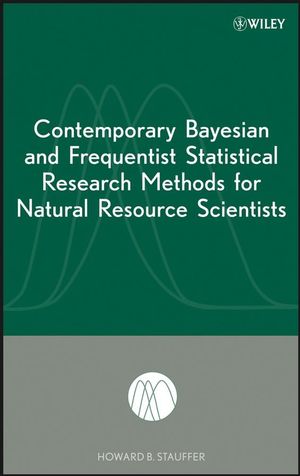Contemporary Bayesian and Frequentist Statistical Research Methods for Natural Resource ScientistsISBN: 978-0-470-16504-1
Hardcover
400 pages
December 2007
 This is a Print-on-Demand title. It will be printed specifically to fill your order. Please allow an additional 10-15 days delivery time. The book is not returnable.
|
||||||
1. Introduction.
1.1 Introduction.
1.2 Three Case Studies.
1.3 Overview of Some Solution Strategies.
1.4 Review: Principles of Project Management.
1.5 Applications.
1.6 S-Plus® and R Orientation I: Introduction.
1.7 S-Plus and R Orientation II: Distributions.
1.8 S-Plus and R Orientation III: Estimation of Mean and Proportion, Sampling Error, and Confidence Intervals.
1.9 S-Plus and R Orientation IV: Linear Regression.
1.10 Summary.
Problems.
2. Bayesian Statistical Analysis I: Introduction.
2.1 Introduction.
2.2 Three Methods for Fitting Models to Datasets.
2.3 The Bayesian Paradigm for Statistical Inference: Bayes Theorem.
2.4 Conjugate Priors.
2.5 Other Priors.
2.6 Summary.
Problems.
3. Bayesian Statistical Inference II: Bayesian Hypothesis Testing and Decision theory.
3.1 Bayesian Hypothesis Testing: Bayes Factors.
3.2 Bayesian Decision Theory.
3.3 Preview: More Advanced Methods of Bayesian Statistical Analysisâ??Markov Chain Monte Carlo (MCMC) Algorithms and WinBUGS Software.
3.4 Summary.
Problems.
4. Bayesian Statistical Inference III: MCMC Algorithms and WinBUGS Software Applications.
4.1 Introduction.
4.2 Markov Chain Theory.
4.3 MCMC Algorithms.
4.4 WinBUGS Applications.
4.5 Summary.
Problems.
5. Alternative Strategies for Model Selection and Inference Using Information-Theoretic Criteria.
5.1 Alternative Strategies for Model Selection and Influence: Descriptive and Predictive Model Selection.
5.2 Descriptive Model Selection: A Posteriori Exploratory Model Selection and Inference.
5.3 Predictive Model Selection: A Priori Parsimonious Model Selection and Inference Using Information-Theoretic Criteria.
5.4 Methods of Fit.
5.5 Evaluation of Fit: Goodness of Fit.
5.6 Model Averaging.
5.7 Applications: Frequentist Statistical Analysis in S-Plus and R; Bayesian Statistical Analysis in WinBUGS.
5.8 Summary.
Problems.
6. An Introduction to Generalized Linear Models: Logistic Regression Models.
6.1 Introduction to Generalized Linear Models (GLMs).
6.2 GLM Design.
6.3 GLM Analysis.
6.4 Logistic Regression Analysis.
6.5 Other Generalized Linear Models (GLMs).
6.6 S-Plus or R and WinBUGS Applications.
6.7 Summary.
Problems.
7. Introduction to Mixed-Effects Modeling.
7.1 Introduction.
7.2 Dependent Datasets.
7.3 Linear Mixed-Effects Modeling: Frequentist Statistical Analysis in S-Plus and R.
7.4 Nonlinear Mixed-Effects Modeling: Frequentist Statistical Analysis in S-Plus and R.
7.5 Conclusions: Frequentist Statistical Analysis in S-Plus and R.
7.6 Mixed-Effects Modeling: Bayesian Statistical Analysis in WinBUGS.
7.7 Summary.
Problems.
8. Summary and Conclusions.
8.1 Summary of Solutions to Chapter 1 Case Studies.
8.2 Appropriate Application of Statistics in the Natural Resource Sciences.
8.3 Statistical Guidelines for Design of Sample Surveys and Experiments.
8.4 Two Strategies for Model Selection and Inference.
8.5 Contemporary Methods for Statistical Analysis I: Generalized Linear Modeling and Mixed-Effects Modeling.
8.6 Contemporary Methods in Statistical Analysis II: Bayesian Statistical Analysis Using MCMC Methods with WinBUGS Software.
8.7 Concluding Remarks: Effective Use of Statistical Analysis and Inference.
8.8 Summary.
Appendix A. review of Linear regression and Multiple Linear regression Analysis.
A.1 Introduction.
A.2 Least-Square Fit: The Linear Regression Model.
A.3 Linear Regression and Multiple Linear Regression Statistics.
A.4 Stepwise Multiple Linear Regression Methods.
A.5 Best-Subsets Selection Multiple Linear Regression.
A.6 Goodness of Fit.
Appendix B. Answers to Problems.
References.
Index.



